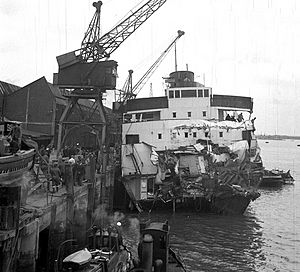TSS Duke of York (1935) facts for kids
Quick facts for kids History |
|
|---|---|
| Name |
|
| Owner |
|
| Operator |
|
| Port of registry | Lancaster, United Kingdom |
| Route | |
| Builder | Harland & Wolff, Belfast |
| Yard number | 951 |
| Launched | 7 March 1935 |
| Completed | 4 June 1936 |
| Out of service | 1975 |
| Identification | Official Number: 128318 |
| Fate | Sold 1963, scrapped 1975 |
| General characteristics | |
| Type | Turbine steam ship |
| Tonnage | 3,743 GRT |
| Length | 339.2 ft (103.4 m) |
| Beam | 55.2 ft (16.8 m) |
| Draught | 17.9 ft (5.5 m) |
| Installed power | 502 NHP |
| Propulsion | Twin screw |
| Speed | 12 Knots |
The Duke of York was a special passenger ship that used steam power. It started sailing in 1935 and was used until 1964. During World War II, its name was changed to HMS Duke of Wellington for a while.
Life as a Passenger Ship
The Duke of York was built in Belfast by Harland & Wolff and finished in 1935. It was made to carry passengers between Heysham and Belfast. It sailed alongside other ships like the RMS Duke of Lancaster and the RMS Duke of Rothesay.
This ship was one of the first to offer a "tourist class" for cross-channel trips. This idea had already been used on bigger ships crossing the Atlantic Ocean since 1928. The Duke of York also had an early automatic fire extinguishing system. It used special glass tubes filled with liquid. When the temperature got too hot, the liquid expanded, breaking the tubes and opening water valves to put out fires.
Serving in World War II
In 1942, the Duke of York was called into service for the war. Its name was changed to HMS Duke of Wellington. This was because there was already a powerful battleship named "Duke of York."
The ship was changed into a "Landing Ship, Infantry (Hand-Hoisting)." This meant it could carry soldiers and special small boats to land them on beaches. It could carry 250 troops and ten Landing Craft Assault boats. It also got a 12-pounder gun and eight anti-aircraft cannons to defend itself.
The Duke of Wellington took part in important wartime events. It was part of Operation Jubilee, a raid on Dieppe in France, on August 19, 1942. It carried Canadian soldiers from The Black Watch (Royal Highland Regiment) of Canada. Later, in 1944, it helped with the Normandy landings, which was a huge operation to land Allied troops in France. After the war ended, it helped transport soldiers between Tilbury and Ostend.
After the War
After the war, the ship went back to its original name, Duke of York. In May 1948, it started a new route, sailing between Harwich and Hook of Holland.
The ship originally had two funnels. But in 1950, it was rebuilt with just one funnel. It was also updated to run on oil instead of coal. It gained cabins for 520 passengers, making it more comfortable.
On May 6, 1953, a foggy day, the Duke of York crashed into an American cargo ship called USNS Haiti Victory. Six passengers sadly died in the accident. The front part of the Duke of York was completely torn off. A brave crew member, William Albert Warner, rescued three people and was later given an award for his heroism.
The ship was rebuilt by Palmers Shipbuilding & Iron Company in Jarrow. They gave it a more modern-looking front and made it about 7 feet longer. The Duke of York returned to its Harwich route in 1954. Its last trip from Hook of Holland was on July 20, 1963. It was then sold in August 1963.
New Name, New Adventures
In 1963, the Duke of York was sold to a company called Chandris Lines. They first renamed it York. The ship then went through more changes at a shipyard. It was fully converted at Chandris Company's own shipyard.
In 1964, it started sailing again with a new name: Fantasia. As Fantasia, it mostly went on cruises in the Eastern Mediterranean Sea. During the winter, it was sometimes rented out to groups on religious tours. The ship stopped sailing in December 1975 and was taken apart for scrap in 1976 in Spain.


